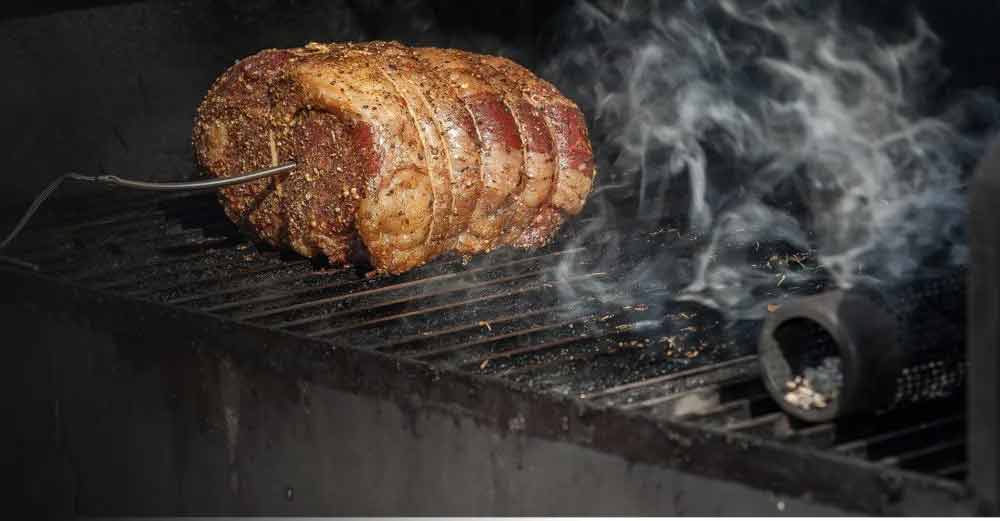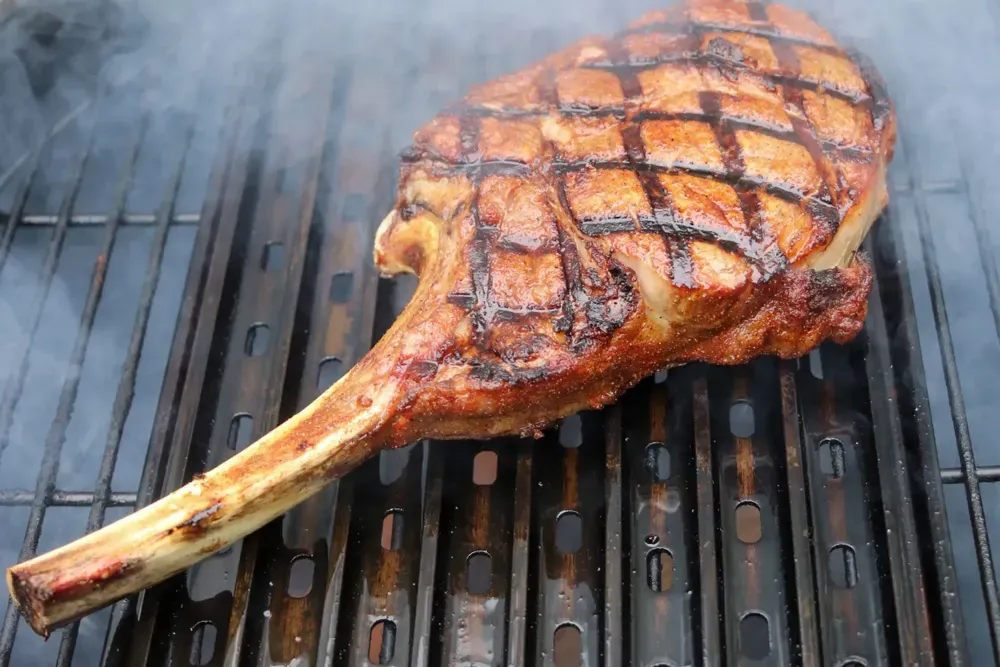
The Reverse Sear
April 30, 2019

Prep Time
Grill Time
Total Time
Categories
The reverse sear is a wonderful technique to use for any large cut of meat whether it be beef, pork, lamb or even chicken. The concept is simple.
Ingredients
Servings
1 large piece of meat (ribeye, pork roast, strip loin, tenderloin)
Seasonings of your choice
Vegetable Oil
Look at the beautiful pink interior of this prime rib- the same shade from bumper to bumper!
Directions
Step 1
Remove the piece of meat you have chosen from refrigeration. Remove any packaging and pat dry with paper towels removing as much moisture as possible from the surface of the meat.
Step 2
Rub or spray the meat with vegetable oil so it has a fine coating.
Step 3
Season with salt and spices of your choice making sure to get a nice coating on all sides. Cover meat and let sit at room temperature.
Step 4
Preheat your grill or smoker to somewhere between 225°F and 240°F.
Step 5
Insert a probe thermometer into the thickest section of the meat. Place meat on the grill surface. Plug probe into thermometer unit.
Step 6
Place ambient temperature probe on the grill making sure the probe is not touching the GrillGrates. Plug into thermometer unit. Close the lid of your cooker.
Step 7
Allow your piece of meat to come within 10 -15 degrees of your target temperature. If you're shooting for a nice medium-cooked piece of beef you will want to remove the meat once the internal temperature gets close to 120°F.
Step 8
Once the meat is removed from the cooker go ahead and increase your heat to grilling temperatures. If using a pellet grill turn your controller to its highest setting. If using charcoal you will now be cooking directly over the coals. If using a gas grill you will want to see temperatures of at least 400°F-500°F on your grills hood thermometer (the GrillGrate surface should be between 600°F and 700°F).
Step 9
Place the meat back on your GrillGrates turning occasionally. For a perfect medium cooked piece of beef remove from the grill once the internal temperature is between 130°F and 135°F.
Step 10



Hi, I copy and pasted this from the article:
8) If using a gas grill you will want to see temperatures of at least 600°F and 700°F on your grills hood thermometer (the GrillGrate surface should be between 550°F and 600°F).
….
Isn’t this the reverse of the manual, which says temperatures on the GrillGrates will be around 150f HIGHER than the dome/lid temperature? Thus, have the grill (in my case a Weber Spirit II E310) at maybe 550-600, and the GrillGrate surface will be 675-700f?
Thanks. Love my GGs!
Robert, WOW! What a great catch. You are right, if you replace on your gas grill the GG surface temp will be hotter, about 200-250°F in fact! I appreciate you pointing this out. I updated it just now.
Happy to help, Emily. Question: During the searing portion of the cook, should the hood be open? I like to rotate 90 degrees for a half minute before turning the steak over.
Hi Robert! I typically like to keep it closed.
Hi, I copy and pasted this from the article:
8) If using a gas grill you will want to see temperatures of at least 600°F and 700°F on your grills hood thermometer (the GrillGrate surface should be between 550°F and 600°F).
….
Isn’t this the reverse of the manual, which says temperatures on the GrillGrates will be around 150f HIGHER than the dome/lid temperature? Thus, have the grill (in my case a Weber Spirit II E310) at maybe 550-600, and the GrillGrate surface will be 675-700f?
Thanks. Love my GGs!
Robert, WOW! What a great catch. You are right, if you replace on your gas grill the GG surface temp will be hotter, about 200-250°F in fact! I appreciate you pointing this out. I updated it just now.
Happy to help, Emily. Question: During the searing portion of the cook, should the hood be open? I like to rotate 90 degrees for a half minute before turning the steak over.
Hi Robert! I typically like to keep it closed.
I do not understand how you are using the flat grill side. Is it for the searing finish or for the “baking” part of cooking the meat?
We are actually not using the flat side in this particular technique. However, as Robert Points out below, when you go back to do your final sear, you could use the flat side just to get a little more sear/char/crust than the rail side.
I do not understand how you are using the flat grill side. Is it for the searing finish or for the “baking” part of cooking the meat?
We are actually not using the flat side in this particular technique. However, as Robert Points out below, when you go back to do your final sear, you could use the flat side just to get a little more sear/char/crust than the rail side.
There is an easy way to take this up a notch further. Use the GrillGrate with the flat side up as a plancha and you can get a better Maillard reaction on the meat.
And, per testing reported by Serious Eats and others, letting a piece of beef sit at room temperature doesn’t do much, you can cook it right out of the refrigerator.
Finally, reverse sear is probably the best way to cook a steak that is at least 1.5- inches thick.
We concur!
There is an easy way to take this up a notch further. Use the GrillGrate with the flat side up as a plancha and you can get a better Maillard reaction on the meat.
And, per testing reported by Serious Eats and others, letting a piece of beef sit at room temperature doesn’t do much, you can cook it right out of the refrigerator.
Finally, reverse sear is probably the best way to cook a steak that is at least 1.5- inches thick.
We concur!